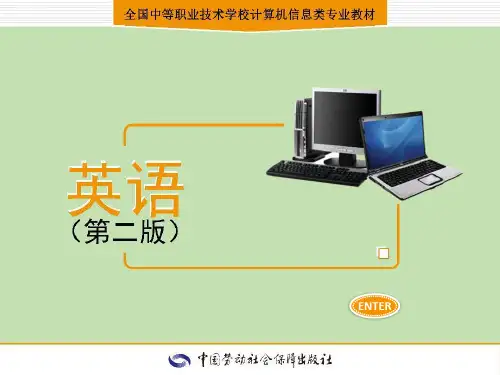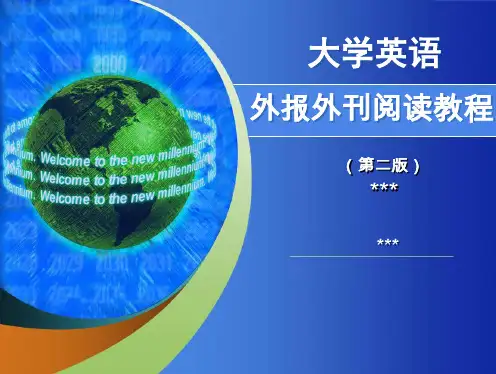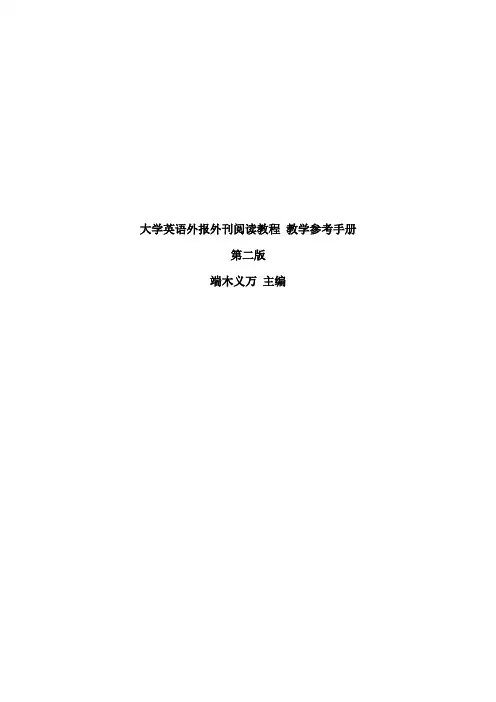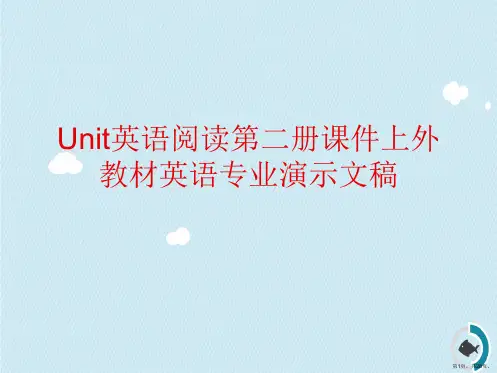大学优品PPT精选版《大学英语外报外刊阅读教材第二版》Lesson10-12
- 格式:ppt
- 大小:4.85 MB
- 文档页数:108





![大学英语外报外刊阅读教程(第二版)课件+教学参考手册 (27)[26页]](https://uimg.taocdn.com/79b23b044b35eefdc8d33381.webp)


大学英语外报外刊阅读教程教学参考手册第二版端木义万主编Answers to the QuestionsV. 1. B 2. B 3. D 4. AVI.1. According to Ms. Wellington, Gen X’ers are attracted to their organizations for utterly traditional reasons: reputation of the organization, opportunities to advance.2. Catalyst and other research organizations caution that this age group has high demands for employers. If their demands are not met, they will leave. And they are highly sensitive to the way in which they are treated. If the Gen X’er believes that his employer is not making a commitment to him, he will leave.3.The survey found that more than 70 percent of them rated companionship, a loving family and enjoying life as extremely important. In contrast, fewer than 20 percent of them said earning a lot of money and becoming an influential leader were extremely important goals.4. According to Robert Morgan, the corporate loyalty is rising in the current economic climate partly because of job insecurities. Besides, there is the war for talent. As labor shortages intensified in recent years, employers have worked hard at retaining good workers.OutlineI.(1) Summary leadIncreasing job loyalty of Gen X’ersII. (2 –6) Catalyst’s survey about job loyalty of Gen X’ers1. General situation of the job loyalty2. Findings about the similarities between Gen X’ers and the previous generationsa. Old-fashioned goalsb. Traditional attractions3. Findings about the differences between Gen X’ers and the previous generationsa. High demands for employersb. High sensitiveness to the way they are treatedIII. (7 – 8) Specific example of Colleen GalleReasons for staying: job satisfactionjob loyaltyIV. (9 – 11) More details of the survey1. Scope, objects and focus of the survey2. Findings about the factors in job loyalty:Companionship, loving family, enjoying life3. Statistics showing job loyaltyV. (12 – 15) Analysis of job loyalty1. Not surprising in the current economic climate2. Comparison between 1999 and 2001 in job loyalty3. Reasons for the increase of job loyaltya. Present job insecurityb. Employers’ efforts at retaining the talentedAnswers to the QuestionsV. 1.A 2.A 3. B 4. DVI.1.The purpose of the debate between Mateo and Martinez is to focus on the specific needs ofLatinos that both parties are courting.2.The problems pointed out by Martinez are bad education, unemployment and lack of healthinsurance.3.The author says Latino turnout and preference will be decisive in the election because they arethe majority minority and more of Latinos than ever before are expected to go to the polls, anda large number of those people are not tied to either political party.4.According to the article, a candidate who figure out how to talk to Latinos about educationand healthcare in a compelling way can lock up Latinos’ vote.5.The term ―Hispanic‖ came into official use in 1973, when the Nixon administration formallydivided Americans into five races. Liberals prefer the term ―Latino‖ on the grounds that the Spaniards were the very people who destroyed the indigenous cultures of Latin Americans) 6.The author thinks that the term ―Hispanic‖is a marketing term and it’s a term used bypoliticians at election time.7.The author thinks that the term ―Hispanic‖is a marketing term and it’s a term used bypoliticians at election time. It cannot reflect cultural realities.OutlineI. (1 – 2) Debate between Mateo and Martinez1. Main issues for the debate and the purpose of the debate2. Audience’s response: louder opponents’ voicesII. (3 – 5) Latinos’ importance in election1. Decisive role of Latino voter turnout and preference2. Reason for the importance of Latino vote: Latinos’ ascent to the majority minority in 20033. Factors limiting Latinos’ voting strengtha. Many of them are not yet US citizens.b. One third of Latinos are under 18.III. (6 – 8) Latinos’ prime concerns1. Importance of education and healthcare to Latinos2. Reasons for the importance of those issuesa. U.S. – born Latinos form the majority.b. It’s more likely for Latinos to lack healthcare and education.IV. (9 – 10) Discussion about the term ―Hispanic‖1. The origin of the term and the problems with the term2. Rich diversity of LatinosV. (11) Increased visibility of LatinosLesson 3Answers to the QuestionsV. 1.C 2.D 3.C 4. AVI.1.WWII led to women’s entry into the workforce. As men marched off to fight, women tooktheir husbands’ places in factories and on the farms. They never looked back. Most now take it for granted that women have as much to offer at work as men do.2.No, it is more than a financial issue because it raises social as well as economic questions andits resolution will involve governments, employers and people.3.The babyboom generation is far larger than the generation that follows it or any that precededit. Its achievement will cast a shadow over the companies it is set to leave.4.The present ways of dealing with a falling supply of labor are shifting work offshore, laxerimmigration rules and use of new equipment.5.If they were offered the chance of staying on at work, many older employees would jump atthe chance because they will no longer be able to retire in the style they have been led to expect. Corporate pension schemes and health benefits are becoming even less generous.Besides the need for money, many elderly people want to continue working for mental stimulation.6.The author thinks that older workers need to adapt and accept a relative decline in salary andstatus7.The significance of babyboomers’changing the world of work will be more profound andlonger lasting than the changes they have brought since the 1960s.OutlineI. (1 – 2) Social changes in western countries after WWII1.Women’s entry into the work force2.Retirement pensions for the elderlyII. (3 – 4) Problems caused by the present retirement pensions1. Heavy burden of financing retirement pensions for babyboomers2. Companies’ shortage of skilled workersIII. (5 – 7) Need to keep the elderly at work1. Present ways of dealing with a falling supply of labour2. Elderly people’s desire for worka. Elderly people’s need for moneyb. Elderly people’s desire for mental stimulationIV. (8 – 10) Suggestions to governments and companies about how to keep the elderly people at work1. Separation of pension from their final salaries2. Freeing up labor markets instead of focusing on legislating to ban discrimination on grounds of age3. Offering flexible work scheduleV. (11) Suggestion to the elderly workersNeed to adapt to a relative decline in salary and statusVI. (12) Significance of babyboomers’ changing the world of workLesson 4Answers to the QuestionsV. 1.D 2.A 3.D 4.BVI.1.According to the new government figures, British female full time workers will be paid£ 369,000 less than their counterparts over their lifetime.2.That lifetime disparity would be enough to pay for 31 years of childcare or 22 new cars, or topay off the average student debt 18 times over.3.Britain’s gender pay gap of 2008 was larger than that of 2007. Men were paid 17.1% morethan women for full-time work while the disparity in part-time wages was 36.6%, up from35.8% in 2007.4.The Fawcett Society has called on the government to include mandatory pay auditing in theequalities bill, scheduled to be introduced in next month’s Queen’s speech.5.According to the article, Sri Lanka is judged the fifth most equal in the world on politicalempowerment because of the long incumbencies as prme minister and president of Sirimavo Bandaranaika and Chandrika Kumaratunga.6.According to Yvonne Galligan, younger parliaments, in general, were often much morerepresentative.7.Dr. Selvi Thriuchandran felt puzzled by the WEF findings, pointing out that aside from theBandaranaikes, Sri Lanka had the worst record in South Asia in terms of representation in the legislature and executive.OutlineI. (1 – 4) ONS’s finding about gender pay gap in Britain1. Lifetime pay gap for female full-time workers2. Gender pay gap’s widening in 20083. Concrete value of the lifetime disparity4. Rake’s comment on the pay gap’s wideningII. (5 – 7) WEF’s finding about UK women’s status’s drop from 11th to 13th in terms of economic, political, health and educational status2. UK’s ranking in terms of progress on equal pay3.Sectors with wide gender pay gapsIII. (8 – 9) Efforts made to address the problem1. Fawcett Society’s call for the inclusion of mandatory pay auditing in the equality bill2. Harriet Harman’s announcement of a requirement to publish gender pay gapsIV. (10 – 12) Analysis of women’s political empowerment1. Analysis of Sri Lanka’s high ranking on political empowerment2. Yvonne Galligan’s analysis of UK women’s political empowermenta. Low percentage in the House of Commonsb. Healthier gender balance in the Scottish parliament and the Welsh assembly3. Women’s higher representation in younger parliamentsV. (13 – 14) Dr. Selvi Thriuchanara’s view on women’s status in Sri Lanka1. Disputing WEF’s conclusion2. Problems faced by women in Sri LankaLesson 5Answers to the QuestionsV. 1.A 2. B 3.D 4. BVI.1.The first power shift is a rebalancing of moral authority. The major factor in the shift is the receding moral superiority of the west.2. The double standard in Paragraph 3 refers to the US different rules for the two financial crises. During the Asian financial crisis, the US bashed Hong Kong when its government intervened in August 1998 in the stock market to fend off the western investment banks and hedge funds bent on destroying the city’s currency. Yet only a month later, the US intervened in the market to bail out LTCM.3. The author thinks that the minor adjustment in voting rights in the World Bank and International Monetary Fund is symbolic of the increase of the east’s say in decision making in global economic affairs.4. Reminbi has gained an elevation in status. Over time , some countries will keep more Reminbi, making it more like reserve currency.5. The recent crisis shows that blindly seeking growth is dangerous. To many wealthy countries, it is unrealistic.6. The five power shifts are for the most part desirable. They provide a more balanced and stable world.OutlineI. (1) Appearance of global rebalancingII . (2 – 6) Rebalancing of moral authority1. Double standard maintained by the West to financial crisis2. Many conflicts of interest inherent in the West’s investment banking3. The West’s moral dilemma in dealing with China4. Equal footing of the two sidesIII. (7 – 8 ) The West’s loss of domination in global economic affairs1. Increase of the East’s say in global economic affairs2. Approach of relative balance between the East and the WestIV. (9) Shift in the center of economic gravity from the Atlantic to the Pacific1. Earlier rise of Japan2. China’s growth momentum and increased economic powerV. (10) Decline of the US dollar’s statusVI. (11) Most developed economies’ switch to the attempt to maintain present growthVII. (12) Effects of the five power shiftsLesson 6Answers to the QuestionsV. 1. D 2.C 3 A 4.AVI.1.The letters which millions of Americans got were quarterly reports telling them what hadhappened to their savings invested in the stockmarket. They have been more effective than any campaign ad.2.Accoring to the Wisconsin Advertising Project, 73% of McCain’s ads and 61% of Obama’sads are negative.3.He thinks that negative campaign ads are more informative than positive ones.4.Obama’s ads attack McCain for the many ways he plans to make life wretched for nearlyeveryone.5.McCain’s attacks on Obama focus on his slender résumé, his dodgy associates and thepossibility that he will raise taxes.6.Some Democrats complain that McCain’s attacks are stoking up violent racial hatred againstObama.7.The author thinks that they are unfounded.OutlineI. (1) Effects of factual adsHelping Obama double his lead over McCainII. (2 – 4) Both sides’ use of negative campaign ads1. Attack ads’ percentage and John Geer’s view on their function2. Obama’s ad attacks on McCain3.McCain’s ad attacks on ObamaIII. (5) Expenditure on attack ads and ways of running those adsIV. (6 – 7) Effects of negative campaign ads1. Worry and complaints about ad attack s’ possible effect of fanning up violence2.Author’s view: unfounded predictionsLesson 7Answers to the QuestionsV. 1. D 2. B 3. A 4. DVI.1. The Conservative Party and the Liberal-Democratic Party have formed the British coalition government.2. Clegg decided that he could not form a coalition with the Labour Party due to a revolt inside the parliamentary Labour Party at the concept of a deal, as well as its likely terms.3. If the deal works, it will change the shape of the Conservative Party.4. The Lib Dems secured 5 cabinet posts and a commitment to 15 other ministerial jobs across Whitehall. On the Conservative side, George Osborne will the chancellor of the exchequer andWilliam Hague foreign secretary.5. The serious problems confronting the coalition government are a huge deficit, deep social problems and a political system in need of reform.6. In the negotiations, the Tories agreed to drop their plans to raise the threshold for inheritance tax and provide extra money for disadvantaged pupils.7. When the Lib Dem-Con deal was secured, George Brown went to the Queen to tender his resignation. Later, he told party workers he was resigning immediately as party leader, leaving Harriet Harman in charge.OutlineI. (1 – 4 ) Formation of the Conservative Party – the Liberal Democratic Party coalition1. Coalition with Cameron as Prime Minister and Clegg as his deputy2. Labour Party’s failure to forge a coalition with Lib Dems3. End of five-day power struggle4. Cameron’s resolveII. ( 5 – 7) The deal and its impact1. The deal making2. The deal impact on the two parties3. Power division between the two partiesIII. (8 – 10) The new government’s resolve1. Admission of some deep and pressing problems2. Call on the people for support3. Promise to form a new kind of governmentIV. (11 – 13) Negotiations and results1. Agreements and compromises reached in the negotiations.2. Lib Dems’ endorsement of the derailed condition dealV. (14 – 16) Brown’s resignation and apology1. Tendering the resignation to the Queen2. Statement about his resignation as party leader3. Apology for his failure to forge a coalitionVI. (17 – 18) Recriminations by the Lib Dems and the Labour on each other1. Lib Dems’ attack on the Labour2. Lord Adonis’s attack on the Lib DemsLesson 8Answers to the QuestionsV. 1. A 2. D 3. D 4. AVI.1. America’s standing in world opinion is at an all-time low. Even its closest allies oppose U.S. policies.2. Its unpopularity is dangerous and expensive. It leads to high military costs abroad, skyrocketingsecurity costs at home, and the loss of trade as America’s goods become shunned overseas. All this causes an economic drain.3. If Americans travelled more, they’d better understand their place on this complex planet and fit in more comfortably, and eventually the U.S. wouldn’t need to spend as much as the rest of the world combined on its military to feel safe.4. Travel helps Americans celebrate, rather than fear, diversity of culture.5. Travel gives Americans a perspective that can translate, through the voting booth, into American policies that will not alienate them from the family of nations. And when that happens, Americans’ safety will be improved.OutlineI (1-2) Need for Americans to gain a better understanding of the world by travellingII (3-5) America’s unpopularity and its harmfu l effects1.America’s low standing in world opinion2.Being routinely outvoted at the U.N. on a variety of issuesIII (6-18) Benefits of thoughtful travel1.Gaining a better understanding of America’s place on the complex planet2.Getting a clear idea about how the world sees America3.Gaining a better understanding about other societiesa. Getting a firsthand look at the complexity and struggles of other societiesb. Helping Americans celebrate diversity of culturec. Helping Americans appreciate the challenges other societies face4.Combating ethnocentrism5.Helping to ensure sound policiesLesson 9Answers to the QuestionsV. 1. C 2. D 3. B 4.BVI.1. It is a non-profit group that promotes the importance of family and fatherhood. It is based in New York.2.The sexual revolution of the 1960s and '70s swept away a concept of dating in which there was an implicit understanding that each party was shopping for a mate and not just for sex.3.If women are not hooking up, they frequently fall into fast-moving, "joined-at-the-hip" relationships with men, spending nights in one another's rooms.4.In the author’s opinion, the rules of courtship in the 1950s were clearer than those of the present. But they proved unfulfilling either, because at that time those who were courting got to know each other under artificial circumstances. They were well dressed and put their best foot forward. This was not the best way to get to know people.OutlineI. (1) News leadSummary of the survey’s reportII. (2—3) The dating scene on college campuses1. Two choices for women2. Women’s desire for long-term relationship and marriageIII. (4) The surveyThe agency doing the investigation; aim, objects and means of the surveyIV. (5—7) Reasons for the appearance of the dating scene1. The sexual revolution2. Women’s lower proportion3. Lack of clear rulesV. (8—10) Main forms of sexual relationship1. Hook-upForms of hookup: kissing, oral sex and intercourse2. Intense, but vague relationship3. Women’s tendency to act like me nVI. (11—12) Impact of the dating scene on marriage1. Less likely to marry or find happiness in marriage2. More likely to marry laterVII. (13—14) The past dating scene1. Rules of courtship: Clearer in the past2. Artificial circumstancesVIII. (15) The problem with both dating scenes: not the right way to know menLesson 10Answers to the QuestionsV. 1.C 2. B 3. C 4. CVI.1. The American traditional family is a family made up of two biological parents and two or threechildren with the father as the only breadwinner.2. No. The traditional family has lost its predominant place. Today only about 20 percent ofAmerican families fit the traditional structure.3. The new American family is a household with fewer children, with both parents working, and with mothers giving birth to their children at an ever older age, having fewer children, and spacing them further apart.4. The stable family of two biological parents is the ideal vessel for molding character, fornurturing, for inculcating values, and for planning for a child’s future.5. The result of America’s family changes is a serious new divide in the American society between the children of poorer, less educated, single parents and those of richer, better educated, and married parents.6. Mother-only families produce harmful effects on children. They are more likely than those with two parents to suffer poverty, to be suspended from school, to have emotional problems, to become delinquent, to suffer from abuse, to take drugs, and to perform poorly on virtually every measure.7. Today, 81 percent of American women think she should have her own career, and 70 percent think that both husband and wife should earn money. The vast majority of working mothers say that even if the family did not need the income, they would continue working.8. The author thinks that America’s Social Security and welfare should be reformed so as to nourish marriage and raise the proportion of children who grow up in two-parent families.OutlineI. (1)Traditional famil y’s loss of its predominanceII. (2)Reasons for traditional family’s loss of its predominance1. Late marriage2. Increased divorce rates3. Cohabitation4. Births to unmarried mothersIII. (3-5)Effects of family changes1. Importance of family stability for children2. Result of family changes3. Harmful effects of single-parent families on childrenIV. (6)Women’s changed concepts on family rolesV. (7-8)Ways to nourish marriage1. Reforming Social Security and welfare2. Educating people about the importance of marriage3. Giving incentives for couples to form and sustain healthy marriageVI. (9)Family trend and the way to deal with the trend1. Shift from traditional to contemporary family2. Tempering the trend by nurturing the American family with public policy in favor ofmarriageLesson 11Answers to the QuestionsV. 1. B 2. D 3. A 4. CVI.1.Kaiser Permanente Bellflower Medical Center had organized a 52-member medical team for delivering the babies with each of them designated and assigned to nurses, doctors and surgical assistants. At 10:43 a.m. on January 26, they were all ready.2. Before the multiple birth, Nadya Suleman was a recently-divorced single mother who already had six children ranging in age from 2 to 7, two of them 2-year-old twins and one of them autistic.3. The news report stoked the furor created by the delivery of the octuplets.4. Nadya Suleman used the last of her remaining embryos and got impregnated through in-vitro fertilization.5. Nad ya Suleman’s mother sees it less glowingly. She believes that her daughter is obsessed and misguided for she already had six beautiful children.6. After being released from the hospital, Nadya Suleman will be faced with problems of child support and child care.OutlineI. (1) Deilvery of Nadya Suleman’s eight babies at Kaiser1. Kaiser’s preparation for the delivery2. Delivery of seven babies3. Delivery of the eighth baby4. Present condition of Nadya Suleman and her eight babiesII. (2) Contr oversy over Nadya Suleman’s multiple birth1. Nadya Suleman’s way of impregnation2. Her mother’s view3. Society’s responses4. Her neighbour’s viewsIII. (3) Nadya Suleman’s obsession with having kids1. Angela Suleman’s explanation of her daughter’s obsession2. Yolanda Novak’s explanation of Nadya’s obsession3. More information about Nadya’s way of impregnationIV. (4) Issue of Nadya Suleman’s impregnation1. Fertility doctor’s stand2. No detail about the impregnation3. K aiser’s advice to Nadya SulemanV. (5-6) Problems facing Nadya Suleman1. Financial support problem2. Childcare problemLesson 12Answers to the QuestionsV. 1.C 2. D 3. A 4. BVI.1. The author suggests that the husband and the wife should offer each other more positive statements, less negative statements, heart-felt and specific compliments and thank-yous.2. Human touch aids the release of feel-good endorphins for giver and receiver.3. To build a fortress of love, he or she should fully support his or her spouse, take his or her spouse’s side whenever possible if trouble arises in the ―outside world‖.4.Trying to improve the spouse puts him/her on the defensive and cast you in a dreary role. The result is that everyone is unhappy.5. When a marriage needs improvement, the true solution is that you should change yourself first,address your own flaws and seek the best in your spouse.6. Good feelings can improve marriage. The happier you feel, the happier your marriage will be and the easier it will be to manage conflicts.7. When conflict is handled with the right tools and attitude, it becomes a gateway to deeper intimacy –the chance to be seen and lived for who you truly are, to accept your mate’s adorable, vulnerable real self and build a strong union without caving in or silently seething.8. A couple should avoid tough talks when they’re not rested well, well fed and when drunk. OutlineI. (1-2) Introduction to the 7 secrets of sexy marriageII. (3-5) Build up love balance1. Function of love balance2. Way to build up love balanceIII. (6-7) Reach out1. Function of human touch and the way to improve it2. Function of fortress of love and the way to build the fortressIV. (8-10) Remember that nobody’s perfect1. Desire to blame your spouse and change him/her2. Harmful effects of trying to change your spouse3. Need to change yourselfV. (11) Add some zing1. Function of attraction2. Way to enhance attractionVI. (12-14) Always fight fairly1. Function of conflict solution2. Right way to handle conflictsVII. (15-17) Pick the right time and place1. The right time for tough talks2. The right place for tough talksVIII. (18) Open your ears1. Importance of listening more2. Right way to respond to a combative talkLesson 13Answers to the QuestionsV. 1. B 2. A 3. D 4. BVI.1. Sam Zell blamed ―a perfect storm‖ of factors behind the Tribune Company’s bankruptcy filing.2.Newspaper Association of America figures show that advertising revenues have been falling since the summer of 2006.3.It was the acceleration of advertising revenues’ fall, coupled with the sheer amount of debt Mr Zell took on to buy Tribune, which led the Los Angeles Times and Chicago Tribune to thebankruptcy courts.4.Moody’s last Month predicted ―dire straits‖ for some publishers in 2009.5.Publishers’ options are shrinking because prospective buyers struggle to find acquisitions.6. The fact that the New York Times wroke down the value of its newspapers showed that asset sales may yield less than once hoped.7. According to Paper Cuts, more than 15,000 U.S newspaper positions have been cut.8. Moody expects most publishers that default to be able to restructure their debt, rather than close titles.OutlineI. (1-4) Newspaper industry’s decline.1.Tribune Company’s bankruptcy filing2. Causes of newspaper industry’s declinea. Debates about the causesb. David Hamburger’s viewII. (5-7) Worsening situation this year1. Acceleration of the deterioration during the four quarters2. Bankruptcy of the Los Angeles Times and Chicago TribuneIII. (8-10) Impact of the financial crisis1. Taking a toll on newspaper groups2. Moody’s prediction of dire straits for some publishers in 20093. Advertising revenue’s, sharp drop resulting form the crisisIV. (11-15) Publishers’ efforts to cope with the situation1. Selling newspapers to raise cash2. Shrinking options for publishers3. Sharp decline of newspaper assets in value4. Reducing staff sizeV. (16-17) Newspaper industry’s prospects1. Most publishers’ ability to restructure their debt rather than close titles2. Staff reduction’s lasting damaging effects on newspaper brandsLesson 14Answers to the QuestionsV. 1. D 2. B 3. C 4. AVI.1. Because they want to improve their public image. They believe that reputations and jobs can belost based on the smallest slip in rank.2. Because they intended to make their colleges more selective. They thought top applicants mightopt for more prestigious i nstitutions, lowering the school’s crucial ―yield‖ and making it appear less desirable.3. If accepted, enrollees tend to boost a school’s yield and its statistical cachet. But the process。
![大学英语外报外刊阅读教程(第二版)课件+教学参考手册 (33)[28页]](https://uimg.taocdn.com/c96ec9e76137ee06eff91887.webp)


大学英语外报外刊阅读教程第二版课程设计一、课程背景在大学英语教学中,英语外报和外刊阅读已经逐渐成为重要的教学手段和手段。
通过阅读外刊,学生可以了解更广泛的社会和文化信息,提高了解全球视野的能力;通过阅读外报,学生可以提高英语的阅读理解能力和全球时事观念,为日后进一步探索国际市场、进行跨国交流奠定基础。
二、课程目标本课程旨在帮助大学英语学生提高英语阅读和理解能力,扩大阅读原文素材,丰富知识和见识。
三、课程内容1. 外刊阅读本课程将会提供世界各地的不同外刊,学生将会学习阅读和理解各种不同的世界文化及时事情报。
2. 外报阅读本课程将提供国际知名媒体的不同外报,学生将可以了解到最新的国际发展,包括政治、经济、文化和体育。
3. 阅读题目学生将阅读一定数量的题目,包括文字阅读、填空和问答。
通过这些题目,学生将提高他们的英语阅读和理解能力。
4. 语言练习学生将会进行一些语言练习,通过这些练习,他们将提高他们的英语口语和写作能力。
四、教师角色在本节課程中,教师的角色将是引导学生,提供指导和鼓励,让学生有信心探索外国文化和最新时事。
教师将为学生提供相应的技巧和策略,帮助他们阅读外刊和外报,提高他们的英语实用能力。
教师将检查学生的阅读、口语和写作并及时进行评估,教师将为学生提供及时的反馈和指导。
五、教学方法1. 阅读指导教师将指导学生如何阅读和理解外刊和外报。
2. 组织学习教师将组织学生阅读文化信息,扩大他们的文化背景,帮助他们扩大阅读素材。
3. 分组讨论教师将组织学生进行分組讨论,让学生了解其他国家的文化和传统,提高他们的社交和团队协作技能。
4. 语言实践教师将组织语言实践,帮助学生提高他们的英语口语和写作能力,让他们能够更好地表达自己的观点。
六、教学评估教学评估将注意学生的英语阅读能力和语言实践能力,包括口语和写作。
学生将进行阅读、口语和写作方面的评估测试。
七、总结本课程将会提供广泛阅读素材,通过外刊和外报,让学生拓宽视野,了解最新时事,扩大他们的文化背景。